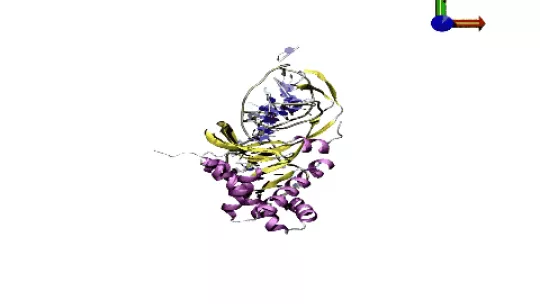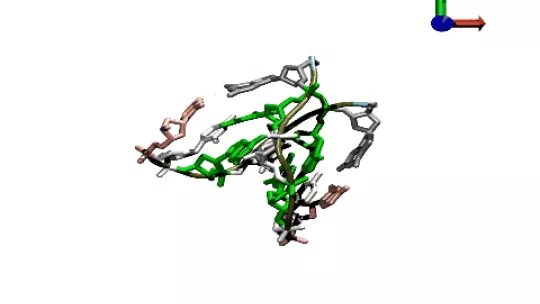Images
The simulation method developed in Modesto Orozco’s laboratory allows the study—with unprecedented accuracy—of structural changes in DNA and of the interaction of DNA with proteins and drugs.
All the simulations and posterior analyses are kept in the first online tool developed to date dedicated to atomic level simulations of nucleic acids.
The platform is free of charge and available to the entire scientific community through the Spanish Institute of Bioinformatics and the European network ELIXIR-Excellerate.
In addition to other uses, the new method provides greater insight into how DNA is recognised by proteins that modify its function or by the drugs that bind to it to exert their therapeutic action, thereby furthering our understanding of the biological function of DNA.
Seeing through simulations what is not possible to observe directly through experimental means. Molecular dynamics is a technique that allows the simulation of DNA movement, its folding into double, triple or quadruple strands, and even its interaction with proteins and drugs. Molecular dynamics is used to address the processes that occur over time scales ranging from picoseconds to minutes and it can be used for molecular systems of various sizes, from few nanometres to a meter.
Headed by Modesto Orozco, the Molecular Modelling and Bioinformatics Lab at the Institute for Research in Biomedicine (IRB Barcelona) are developing several theoretical methods to better understand the behaviour of bio-macromolecules, in particular nucleic acids, on a wide spatial-temporal scale and with a focus on biomedical and biotech applications.
Today the group has published a new model in Nature Methods. Developed in collaboration with the Barcelona SuperComputing Center (BSC) and laboratories in England and the US, this model allows atomic-level simulations of DNA dynamics and, to the great satisfaction of the researchers,“with extraordinary accuracy”—an achievement that has taken 5 years of work and the testing of more than 100 DNA systems.
The data are stored in a public website that currently holds more than 4 Terabytes of information: http://mmb.irbbarcelona.org/ParmBSC1/. This web site is accessible through the Spanish Institute of Bioinformatics (INB) and the ELIXIR-Excellerate network, the largest collection of life sciences data in Europe, to which IRB Barcelona contributes.
The scientists have developed what is called a force-field, a set of mathematical functions that describe the movement of the atoms that form DNA. “A force-field has never previously allowed the study of such diverse structures in time scales relevant for understanding biological phenomena,” assures Pablo Dans Puiggròs, IRB Barcelona researcher and first author of the paper, together with Ivan Ivani, a PhD student in the same lab.
In addition, the authors present the first online tool devoted to the simulation of nucleic acids, emphasizing that “it allows to predict DNA properties, which can then be compared directly with experiments”. “We hope that this new tool and method will open our work to a wider community of users” says Modesto Orozco, director of the project.
The tool has potential applications in fields ranging from biomedicine to nanotechnology, providing information on mechanisms that underlie DNA regulation and contributing to improvements in the design of drugs that directly or indirectly target DNA. “We are achieving a quantitative leap in the quality of atomic DNA simulations,” states Pablo Dans Puiggròs.
“Advances in simulation are bringing us closer to the definition of a theoretical model that will allows us to simulate key aspects of cell life, therefore approaching the dream of being able to describe the behaviour of organisms only based on the basic rules of physics and chemistry,” says Modesto Orozco, who is also a senior professor at the University of Barcelona and director of the Life Sciences Department at BSC.
The work, funded by the European Research council (ERC Advanced Grant), the Ministry of the Economy, the Government of Catalonia, and the Spanish Institute for Bioinformatics, is the result of collaboration between IRB Barcelona and BSC through a joint Computational Biology programme.
Reference article:
Parmbsc1: as refined force-field for DNA simulations
I Ivani, P D. Dans, A Noy, A Pérez, I Faustino, A Hospital, J Walther, P Andrio, R Goñi, ABalaceanu, G Portella, F Battistini, J LlGelpí, C González, M Vendruscolo, C A. Laughton, S A. Harris, D A. Case,and M Orozco
Nature Methods (2015). Doi: 10.1038/nmeth.3658
About IRB Barcelona
The Institute for Research in Biomedicine (IRB Barcelona) pursues a society free of disease. To this end, it conducts multidisciplinary research of excellence to cure cancer and other diseases linked to ageing. It establishes technology transfer agreements with the pharmaceutical industry and major hospitals to bring research results closer to society, and organises a range of science outreach activities to engage the public in an open dialogue. IRB Barcelona is an international centre that hosts 400 researchers and more than 30 nationalities. Recognised as a Severo Ochoa Centre of Excellence since 2011, IRB Barcelona is a CERCA centre and member of the Barcelona Institute of Science and Technology (BIST).















